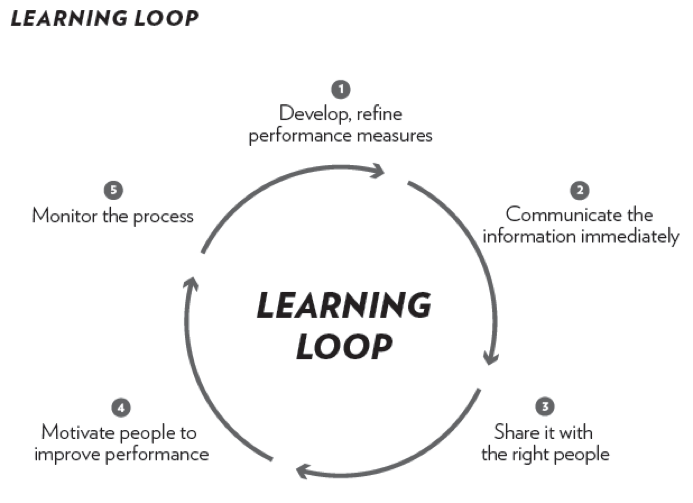Learning is part of life. What’s more, learning is essential for a fulfilling career. When we’re not learning and growing, we tend to feel stuck, are more likely to feel depressed, disenchanted and discontent with our career progress. No one likes feeling like they’re stuck in a rut. Often, we feel like we want to learn new and challenging things, but we just don’t know where to start. Learning is a skill in and of itself. We have to look at learning as a life long process of meta-learning, aka learning how to learn.
There’s a caveat, and that’s the fact that learning something well takes time. And, time is a resource that we have less and less of as we progress through our careers. That’s why we need a feedback loop that tells us if our we’re actually getting better, or if we need to tweak our strategy. It’s the only (and best) way to be an effective learner and get the result we’re striving for. So, what’s a feedback loop anyway?
What’s a feedback loop
A feedback loop is just a process of understanding how causes and effects work together.
“Feedback loops allow organisms and systems to maintain control of important processes by signalling back whether an input should be intensified or stopped.” – Learning Theories
Feedback loops are rife in our bodies. Our brain sends a signal to our body, which send another signal back to our brain, which tweaks the signal and sends it back to our body… etc. Remember the time you accidentally touched a hot stove or iron? Your hand touched the hot surface and sent a signal to your brain, your brain tells your hand “hey, that’s hot, pull your hand away immediately,” and then you suddenly wrench your hand off the hot surface and begin to nurse your wounds. Without this amazing feedback loop, you’d keep burning your hand to a crisp without taking it off the hot surface. That’s why we need feedback loops for effective learning. Without them, we’d keep repeating the same terrible learning strategies with no benefit to our future growth and development.
There are two types of feedback loops, negative and positive.
Negative feedback loops
These are feedback loops that maintain homeostasis. It basically aims to keep things the same and balanced. That’s why we sweat when we get too hot or shiver when we’re cold; our brain is trying to maintain a constant body temperature that is optimal for our survival (about 37 degrees Celsius). Without negative feedback loops, we’d be in trouble because we wouldn’t be able to survive. It keeps an optimal internal environment for our survival.
Positive feedback loops
Positive feedback loops are about growth and development. They’re about creating something new and different. Childbirth is an example of this because the body has to move away from homeostasis and focus on the uncanny process of safely birthing the baby. It’s quite amazing (aside from the unbearable pain, of course!). Positive feedback loops take the body out of its normal ‘safety’ boundaries to ensure that new life is brought into the world and survival can continue.
So, negative feedback loops keep things the same, and positive feedback loops make sure that we’re growing and developing. Both are essential for learning.
What’s a learning feedback loop
Feedback loops expose whether your learning strategy is effective. The last thing you want is to spend your precious time using a strategy that doesn’t bring any tangible results – or accidentally learning the wrong thing over and over again – simply because no expert was able to tell you otherwise.

Set goals and define outcomes
You have to define what you want to learn, how proficient you want to be, and when you want to have the skill under your belt.
Using a S.M.A.R.T. goal framework is a great place to start. It helps you set specific, measurable, attainable, relevant and timely goals.
Goals are just a mental signpost that tells you which way you’re planning to go. Outcomes are the real fruits of your labour; they’re the results at the end of your strategy. You want to specify your learning task outcomes so you can make the best decisions about what to learn, how you’re learning and why you’re learning it in the first place.
Start with the smallest and simplest elements
The biggest hurdle that makes learners quit is having unrealistic expectations. They jump into their new learning challenges, start with a complex element, and then expect to master their new skill in a short time. No wonder they quit. The key is to start simple and maintain realistic time frames. Otherwise, you’ll just get frustrated, burnt out, and end up driving yourself insane.
The Japanese concept of ‘Kaizen’ is important to keep in mind. It’s about making small improvements each day, every day. It’s about consistency and making a small effort toward your big learning goal. Often, we get a burst of motivation when we start learning a new thing, we make grand leaps forward, burn out, take a break and then give up altogether. Kaizen makes sure that we don’t fall into this trap.
Have a proof of concept
We have to regularly test ourselves to see if we’re actually learning. Tests don’t have to be in the form of exams, they just need to provide a proof of concept that your learning strategy is actually working.
You can conduct a proof of concept by:
-
Having an in-depth conversation about your topic
-
Receiving good feedback on a task that uses your new skill
-
Measuring your task efficiency before your new skill vs. after your new skill
-
Taking an online test to determine your knowledge
-
Take an online course to see what you already know and find any gaps in knowledge
Get a mentor
A mentor is a great resource. They help you learn things faster and more holistically. The best thing about mentors is their real-life experience, the stuff that you won’t find in books and courses. A mentor also points out the gaps that we have in our skillset, which meant that they can objectively tell us what we need to learn. This saves us a lot of time and helps us to direct our effort toward the most valuable areas. Mentors also motivate us – they keep us going when things get challenging. You know the feeling, when we don’t get something, we feel stupid, like we’re not cut out for the challenge at hand. In these moments, mentors remind you of how far you’ve come and they show you what you’re good at – something that most of us tend to forget and overlook.
Teach what you’ve learned
Find someone and teach them something you’ve learned using your own words. Teaching is one of the best ways to learn something because it forces you to be creative and see things from different angles. When you teach, you simplify tough concepts to help the other person understand. It ends up solidifying what you’ve learned as you recall and distill all your learnings into condensed packets of knowledge.


